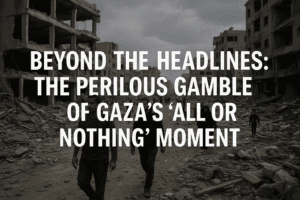Beyond the Headlines: The Perilous Gamble of Gaza’s “All or Nothing” Moment
Facing failed cease-fire talks and mounting pressure over hostages and starvation, U.S. and Israeli officials now demand an “all or nothing” Gaza deal. This requires Hamas to release all living hostages and bodies, agree to a permanent ceasefire, and disarm—in exchange for prisoner releases and an end to the war. Hamas insists it will not surrender its weapons without achieving Palestinian statehood, a condition Israel rejects. Meanwhile, families of hostages condemn the shift as “empty slogans,” noting Israel’s preconditions are unrealistic.
As Netanyahu walks a political tightrope between hardline ministers and desperate families, Hamas exploits Gaza’s humanitarian crisis as leverage. With both sides entrenched in mutually exclusive demands—Israel seeking Hamas’s destruction, Hamas demanding survival—the “comprehensive” push appears less like a solution and more like an admission of deadlock. Civilians remain trapped between starvation and unrelenting violence, while leaders refuse the painful compromises needed for peace.

Beyond the Headlines: The Perilous Gamble of Gaza’s “All or Nothing” Moment
The grinding tragedy of Gaza has entered a new, potentially more dangerous phase. After months of stalled cease-fire negotiations focused on incremental steps, U.S. and Israeli officials are abruptly shifting their rhetoric towards demanding an “all or nothing” comprehensive deal. This sudden pivot, driven by desperation and mounting pressure, faces steep obstacles and risks deepening the existing stalemate.
The Shifting Sands of Negotiation:
- From Phased to Final: Previously, talks centered on a two-phase approach: a 60-day truce and partial hostage release, deferring the thorniest issues – like ending the war and Hamas’s future – for later. This pragmatic, albeit limited, path has collapsed.
- The New Ultimatum: The emerging demand, articulated by U.S. Envoy Steve Witkoff to hostage families and echoed in Israeli media reports, is stark: Hamas must release all remaining living hostages (Israel believes 20 survive) and the bodies of the dead (30), agree to a permanent ceasefire, and crucially, disarm. In return, Israel would release Palestinian prisoners and end the war. Failure means intensified military action.
- The Drivers: This shift isn’t born of optimism but crisis:
- Hostage Anguish: Graphic new videos showing emaciated, frail hostages (like Omri Miran and Nadav Popplewell) shocked Israel, amplifying families’ desperate pleas and public pressure on the government.
- Humanitarian Catastrophe: International condemnation over Israel’s aid restrictions and the resulting widespread starvation in Gaza has reached a fever pitch, isolating Israel further.
- Political Pressure: Netanyahu faces intense domestic friction – hostage families demand action, while hardline ministers like Itamar Ben-Gvir openly advocate for conquering Gaza and eliminating Hamas.
Why “All or Nothing” Faces a Wall of “No”:
- Hamas’s Unyielding Core Demand: Mahmoud Mardawi, a Hamas official, confirmed the group wants a comprehensive deal in principle – but one centered on ending the war, prisoner releases, and “day-after arrangements” on their terms. Disarmament? “We will not hand over our weapons,” Mardawi stated, linking it solely to achieving Palestinian statehood – a non-starter for the current Israeli government.
- Mutually Exclusive Endgames: Israel demands Hamas’s military destruction or surrender as a prerequisite for peace. Hamas demands an end to the war without relinquishing its arms or its claim to governance. These positions are fundamentally irreconcilable under the current leaderships. As analyst Ehud Yaari notes, Hamas is essentially demanding “a full victory” for releasing hostages.
- The Leverage Paradox: Hamas views the humanitarian crisis and hostage plight as strategic leverage. “What is the point of talks when people are dying of starvation?” Mardawi asked rhetorically. This brutal calculus makes concessions seem less likely, not more, amid suffering.
- Netanyahu’s Precarious Tightrope: Pushing a “comprehensive deal” allows Netanyahu to appear proactive to hostage families and the international community. However, accepting terms Hamas would agree to (no disarmament, Hamas remaining in power) would shatter his coalition. Conversely, the proposed ultimatum risks entrenching the status quo: continued war, hostages in peril, and Gaza starving.
- The Hollow Slogan?: Families like Efrat Machikawa, whose relative was released, see the new rhetoric as empty. “The preconditions set by Israel are unrealistic and unworkable,” she stated, reflecting deep skepticism born of months of failed talks and shifting government positions. Ruby Chen, father of a hostage now presumed dead, lamented, “We lost six months on this” incremental approach.
The Human Cost Endures:
While diplomats posture, the reality on the ground remains horrific:
- Starvation as Policy Tool: Israel’s severe aid restrictions, justified by claims of diversion (claims even some Israeli military officials reportedly found unsubstantiated regarding systematic UN theft by Hamas), have weaponized hunger.
- Unrelenting Violence: Israeli strikes continue (e.g., the reported hit on a Red Crescent office in Khan Younis, killing a staffer). Hamas maintains its capacity to launch attacks.
- The Toll: Beyond the staggering death toll (over 60,000 Palestinians per Gaza health authorities), the physical and psychological devastation for Gaza’s 2 million survivors is immeasurable.
The Path Ahead: Brinkmanship or Breakthrough?
The “all or nothing” gambit feels less like a viable strategy and more like an admission of the failure of incrementalism, coupled with an attempt to manage overwhelming pressures. It presents Hamas with an impossible demand (disarmament) while offering Israel a potential justification for prolonged conflict if rejected.
True insight lies in recognizing this paradox: A “comprehensive deal” is the only sustainable solution, but the maximalist demands attached to this new push make it currently unattainable. The tragic reality is that this shift may simply reframe the deadlock, raising the stakes without providing a credible path forward. The hostages remain in tunnels, Gazans starve in the ruins, and leaders remain trapped by their own red lines and the grim arithmetic of a conflict where compromise feels like defeat to both sides. The window for a breakthrough narrows as the human cost mounts daily, demanding not just new slogans, but genuine, painful concessions that leaders have so far been unwilling to make.
You must be logged in to post a comment.